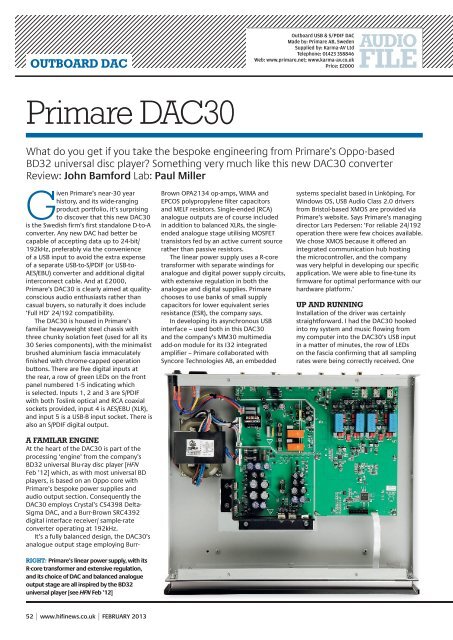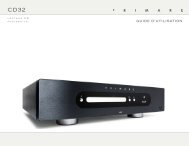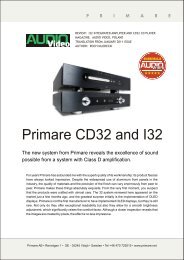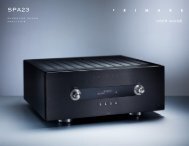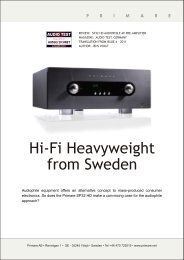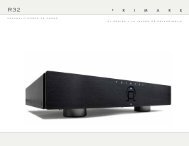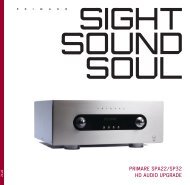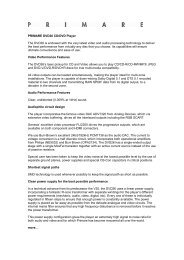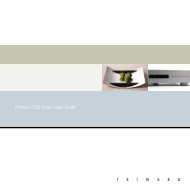You also want an ePaper? Increase the reach of your titles
YUMPU automatically turns print PDFs into web optimized ePapers that Google loves.
OUTBOARD DAC<br />
<strong>Primare</strong> <strong>DAC30</strong><br />
52 | www.hifi news.co.uk | FEBRUARY 2013<br />
Outboard USB & S/PDIF DAC<br />
Made by: <strong>Primare</strong> AB, Sweden<br />
Supplied by: Karma-AV Ltd<br />
Telephone: 01423 358846<br />
Web: www.primare.net; www.karma-av.co.uk<br />
Price: £2000<br />
What do you get if you take the bespoke <strong>eng</strong>ineering from <strong>Primare</strong>’s Oppo-based<br />
BD32 universal disc player? Something very much like this new <strong>DAC30</strong> converter<br />
Review: John Bamford Lab: Paul Miller<br />
Given <strong>Primare</strong>’s near-30 year<br />
history, and its wide-ranging<br />
product portfolio, it’s surprising<br />
to discover that this new <strong>DAC30</strong><br />
is the Swedish fi rm’s fi rst standalone D-to-A<br />
converter. Any new DAC had better be<br />
capable of accepting data up to 24-bit/<br />
192kHz, preferably via the convenience<br />
of a USB input to avoid the extra expense<br />
of a separate USB-to-S/PDIF (or USB-to-<br />
AES/EBU) converter and additional digital<br />
interconnect cable. And at £2000,<br />
<strong>Primare</strong>’s <strong>DAC30</strong> is clearly aimed at qualityconscious<br />
audio enthusiasts rather than<br />
casual buyers, so naturally it does include<br />
‘Full HD’ 24/192 compatibility.<br />
The <strong>DAC30</strong> is housed in <strong>Primare</strong>’s<br />
familiar heavyweight steel chassis with<br />
three chunky isolation feet (used for all its<br />
30 Series components), with the minimalist<br />
brushed aluminium fascia immaculately<br />
fi nished with chrome-capped operation<br />
buttons. There are fi ve digital inputs at<br />
the rear, a row of green LEDs on the front<br />
panel numbered 1-5 indicating which<br />
is selected. Inputs 1, 2 and 3 are S/PDIF<br />
with both Toslink optical and RCA coaxial<br />
sockets provided, input 4 is AES/EBU (XLR),<br />
and input 5 is a USB-B input socket. There is<br />
also an S/PDIF digital output.<br />
A FAMILAR ENGINE<br />
At the heart of the <strong>DAC30</strong> is part of the<br />
processing ‘<strong>eng</strong>ine’ from the company’s<br />
BD32 universal Blu-ray disc player [HFN<br />
Feb ’12] which, as with most universal BD<br />
players, is based on an Oppo core with<br />
<strong>Primare</strong>’s bespoke power supplies and<br />
audio output section. Consequently the<br />
<strong>DAC30</strong> employs Crystal’s CS4398 Delta-<br />
Sigma DAC, and a Burr-Brown SRC4392<br />
digital interface receiver/ sample-rate<br />
converter operating at 192kHz.<br />
It’s a fully balanced design, the <strong>DAC30</strong>’s<br />
analogue output stage employing Burr-<br />
RIGHT: <strong>Primare</strong>’s linear power supply, with its<br />
R-core transformer and extensive regulation,<br />
and its choice of DAC and balanced analogue<br />
output stage are all inspired by the BD32<br />
universal player [see HFN Feb ’12]<br />
Brown OPA2134 op-amps, WIMA and<br />
EPCOS polypropylene fi lter capacitors<br />
and MELF resistors. Single-ended (RCA)<br />
analogue outputs are of course included<br />
in addition to balanced XLRs, the singleended<br />
analogue stage utilising MOSFET<br />
transistors fed by an active current source<br />
rather than passive resistors.<br />
The linear power supply uses a R-core<br />
transformer with separate windings for<br />
analogue and digital power supply circuits,<br />
with extensive regulation in both the<br />
analogue and digital supplies. <strong>Primare</strong><br />
chooses to use banks of small supply<br />
capacitors for lower equivalent series<br />
resistance (ESR), the company says.<br />
In developing its asynchronous USB<br />
interface – used both in this <strong>DAC30</strong><br />
and the company’s MM30 multimedia<br />
add-on module for its I32 integrated<br />
amplifi er – <strong>Primare</strong> collaborated with<br />
Syncore Technologies AB, an embedded<br />
systems specialist based in Linköping. For<br />
Windows OS, USB Audio Class 2.0 drivers<br />
from Bristol-based XMOS are provided via<br />
<strong>Primare</strong>’s website. Says <strong>Primare</strong>’s managing<br />
director Lars Pedersen: ‘For reliable 24/192<br />
operation there were few choices available.<br />
We chose XMOS because it offered an<br />
integrated communication hub hosting<br />
the microcontroller, and the company<br />
was very helpful in developing our specifi c<br />
application. We were able to fi ne-tune its<br />
fi rmware for optimal performance with our<br />
hardware platform.’<br />
UP AND RUNNING<br />
Installation of the driver was certainly<br />
straightforward. I had the <strong>DAC30</strong> hooked<br />
into my system and music fl owing from<br />
my computer into the <strong>DAC30</strong>’s USB input<br />
in a matter of minutes, the row of LEDs<br />
on the fascia confi rming that all sampling<br />
rates were being correctly received. One<br />
052-055 <strong>Primare</strong> <strong>DAC30</strong>_v4_SPCBPM.indd 52 17/12/12 12:18:43
of <strong>Primare</strong>’s C23 multi-function system<br />
remote controllers is supplied with the<br />
<strong>DAC30</strong>, its numbered keys providing direct<br />
input selection as well as the up/down<br />
keys allowing scrolling through inputs. The<br />
Dim button, which adjusts the brightness<br />
levels of the display in many <strong>Primare</strong><br />
components, turns the <strong>DAC30</strong>’s indicator<br />
LEDs off/on. The power button operates<br />
the DAC too – but other<br />
than this there’s nothing<br />
else to control, as there are<br />
no digital fi lter options or<br />
up-sampling modes from<br />
which to choose.<br />
Criticisms? As with<br />
many DACs that employ<br />
relay-controlled mute<br />
circuits, you’ll often miss the fi rst second<br />
or so of music when you play consecutive<br />
music tracks that have different sampling<br />
rates, necessitating restarting the track.<br />
Frankly, I can live with this – I’ve become<br />
accustomed to it as a common issue.<br />
Also, the <strong>DAC30</strong> doesn’t remember the<br />
last input selected when powered down.<br />
PRIMARE’S PAST<br />
‘Marsalis’ sax<br />
wailed clearly<br />
above dense<br />
keyboard layers’<br />
When you bring it out of standby it always<br />
defaults to Input 1. This I did fi nd mildly<br />
irritating and I’d like to see <strong>Primare</strong> address<br />
this in a future revision.<br />
COMPOSURE RETAINED<br />
I can imagine the <strong>DAC30</strong> sounding<br />
wonderful in unison with one of <strong>Primare</strong>’s<br />
crisp and super-vivid UFPD Class D<br />
amplifi ers, as it has a<br />
richly-coloured warm tone<br />
with delicate treble and<br />
really ‘ballsy’ bass. I was<br />
struck from the outset<br />
by its bold and powerful<br />
depiction of bass<br />
dynamics and descriptive<br />
detailing of bass textures<br />
when playing Sting’s ‘Children’s Crusade’<br />
from The Dream Of The Blue Turtles [A&M<br />
393 750-2], while doing my utmost<br />
to ignore the unnecessary electronic<br />
treatments in the recording (Sting’s voice<br />
swimming in cavernous artifi cial reverb).<br />
The <strong>DAC30</strong> allows you to hear all the<br />
way into a recording’s noise fl oor, pulling<br />
<strong>Primare</strong>’s history dates back to the mid-1980s, its iconic 900 Series components<br />
causing design-conscious audiophiles to go weak at the knees. It was the work of<br />
Scandinavian designer Bo Christensen, one of the most creative and inspirational<br />
industrial designers the world of audio has ever seen. Lars Pedersen, managing<br />
director and owner of <strong>Primare</strong> Systems, has been at the helm since 1996. As a<br />
young entrepreneur he was the Scandinavian importer of British-made Target<br />
loudspeaker stands, and by the 1990s had a business (Xena Audio) that owned<br />
<strong>Primare</strong>, Copland and QLN before he chose to focus on <strong>Primare</strong>. What was a<br />
niche ultra-high-end marque has grown into a successful brand that today covers<br />
multi-channel AV electronics as well as specialist two-channel analogue and<br />
digital audio components. Manufacturing is mostly in the Far East, <strong>Primare</strong>’s<br />
chief electronics designer Bent Neilsen and co-product development <strong>eng</strong>ineer<br />
Bjørn Holmqvist juggling their time between supervising suppliers in Taiwan and<br />
China and at the company’s design and testing headquarters in Växjö, Sweden<br />
where fi nal assembly and soak testing is undertaken.<br />
ABOVE: Available in black or titanium fi nish,<br />
the <strong>Primare</strong>’s aluminium fascia sports on/off<br />
and input selector buttons, with LEDs indicating<br />
active input and incoming sampling frequency<br />
out delicious detail from a beautifully dark<br />
background. During the rather diffi cult<br />
middle section of Sting’s anthem – diffi cult,<br />
that is, for a hi-fi system to deliver it<br />
without seemingly collapsing into a wall of<br />
noise – as the level increases and Branford<br />
Marsalis’s parping saxophone joins in the<br />
mix, the <strong>DAC30</strong> retained its composure<br />
admirably. The ride and crash cymbals had<br />
natural ‘ring’ while the saxophone wailed<br />
clearly above the increasingly dense layers<br />
of keyboards, the <strong>Primare</strong> serving up a<br />
coherent image throughout the piece.<br />
Later in the album, during ‘We Work The<br />
Black Seam’ with its Police-esque ‘white<br />
reggae’ beat, the DAC’s excellent resolving<br />
ability allowed transparent differentiation<br />
between kick drum and plucked bass notes,<br />
and the clarity of the hypnotic keyboard<br />
patterns in the background helped make<br />
the song <strong>eng</strong>agingly rhythmic.<br />
Regular readers will be familiar with<br />
my listening room and resident amplifi er/<br />
speaker rig [go to www.hifi news.co.uk<br />
and click on ‘Meet the Team’]. Currently<br />
I’m using a Mac Mini (2.2gGHz/8Gb RAM)<br />
running JRiver Media Center v.17 playback<br />
software under Windows 7, driven from<br />
a recently acquired Dell ST2220T touchscreen<br />
monitor. I’ve spent the last four<br />
years gradually transferring my entire CD<br />
collection to a 2TB HDD, and with my<br />
selection of hi-res recordings added to<br />
the library, playing out from computer<br />
has inexorably become the predominant<br />
listening source both for pleasure and<br />
critical audio component analysis.<br />
With <strong>Primare</strong>’s <strong>DAC30</strong> in the replay<br />
chain, using its asynchronous USB input,<br />
I was utterly blown away by the playback<br />
FEBRUARY 2013 | www.hifi news.co.uk | 53<br />
052-055 <strong>Primare</strong> <strong>DAC30</strong>_v4_SPCBPM.indd 53 17/12/12 12:18:44
OUTBOARD DAC<br />
ABOVE: Balanced (XLR) and single-ended (RCA) analogue outs are joined by AES/EBU<br />
(XLR) and USB digital inputs alongside three Toslink optical and three coaxial S/PDIF<br />
of a 24-bit/96kHz fi le of a recording<br />
of Norwegian pianist Helge Lien. I<br />
was listening to ‘Diverted Dance’<br />
by the Helge Lien Trio, from Hello<br />
Troll Germany’s Ozella Music<br />
imprint [24/96 FLAC download from<br />
highresaudio.com]. The transient<br />
attack of the keyboard notes was<br />
startlingly real, the natural decay of<br />
reverb creating a palpable image of<br />
a piano at the end of my room as my<br />
monitors seemed to ‘disappear’.<br />
The sharp tinkle of Indian bells<br />
that fi rst marks the introduction of<br />
drum kit and bass accompaniment<br />
leapt forward in holographic fashion<br />
– and once the trio got into its stride<br />
I was treated to swathes of rich,<br />
creamy and abundant bass alongside<br />
the drummer’s sizzling cymbals and<br />
Lien’s modal piano workout.<br />
TEMPERED BY CIVILITY<br />
Coupled with the <strong>Primare</strong> DAC’s<br />
subjectively bold and powerful<br />
disposition through the bass and<br />
midband is a hint of gentleness in<br />
its reproduction of high frequencies.<br />
I wouldn’t describe it as soft, but<br />
it is smooth and ‘sweet’, sounding<br />
refi ned both via its USB and S/PDIF<br />
inputs. Whether you’ll consider it<br />
an upgrade to your CD player will<br />
depend entirely on the performance<br />
of your player of course. Certainly<br />
it added verve and gravitas to the<br />
performance of an ageing Stable<br />
Platter Mechanism-equipped Pioneer<br />
PD-S06 CD player I had, that itself<br />
has a polished and refi ned sound.<br />
Using the player as a disc<br />
transport, adrenalin-fuelled rock<br />
music and large-scale orchestral<br />
works gained muscularity and<br />
dynamic potency – with better<br />
resolution of fi ne detail as well.<br />
Rarely were recordings delivered in<br />
a raucous, up-front manner. Most<br />
of the time the <strong>DAC30</strong>’s smooth<br />
treble ensured that its authoritative<br />
energy was tempered with a<br />
degree of civility, encouraging long<br />
listening sessions. Nevertheless<br />
the <strong>Primare</strong> can’t make everything<br />
sound gloriously listenable. Beverley<br />
‘the voice’ Knight’s rousing ‘Come<br />
As You Are’ from 2006’s The Best<br />
Of… retrospective [Parlophone<br />
0946 354566 2 2] was shown<br />
to be quite horrible (more’s the<br />
pity), dynamically squashed and<br />
bandwidth limited.<br />
Her premier-league vocals,<br />
double-tracked extensively in<br />
the song, might just as well have<br />
been recorded down a couple<br />
of telephone mouthpieces. The<br />
<strong>eng</strong>ineer responsible might learn<br />
from listening to a recording of<br />
Scott Walker from more than three<br />
decades earlier. I was playing Boy<br />
Child: The Best of Scott Walker<br />
1967-1970 [Fontana 842 832-2],<br />
admiring ‘The War Is Over (Sleepers)’<br />
taken from his 1970 long player<br />
’Til The Band Comes In. The slightly<br />
distant, shut-in quality of the<br />
string arrangement betrayed the<br />
recording’s vintage sure enough,<br />
but the clarity of Walker’s voice was<br />
sublime. Some might say: ‘It must<br />
have been the tubes…’<br />
HI-FI NEWS VERDICT<br />
This is a great sounding D-to-A<br />
converter that can be strongly<br />
recommended to audiophiles<br />
looking for a straightforwardin-use<br />
DAC for a high resolution<br />
computer audio system setup. It’s<br />
perhaps a little expensive given<br />
its limited feature set, but that<br />
classy casework doesn’t come<br />
cheap – and you can certainly fi t<br />
it and forget it. Its tremendous<br />
sound quality will prove highly<br />
rewarding in top-fl ight systems.<br />
Sound Quality: 84%<br />
0 - - - - - - - - 100<br />
LAB<br />
REPORT<br />
PRIMARE <strong>DAC30</strong><br />
When <strong>Primare</strong> says that the <strong>DAC30</strong> ‘incorporates the supreme<br />
processing <strong>eng</strong>ine of the award-winning BD32 universal<br />
player’ it might also mention that the two-channel CS4398<br />
DAC-based analogue stage also looks to be lifted from this<br />
chassis [see HFN Feb ’12]. The 4.3V output from its XLRs is<br />
the same, as is the 113.5dB A-wtd S/N ratio and, tellingly, the<br />
97ohm source impedance. The output is also phase-inverting,<br />
so you might want to fl ip your speaker leads before doing any<br />
meaningful comparisons. The responses with 48kHz, 96kHz and<br />
192kHz are also the same as we recorded for the BD32, and<br />
consistent between S/PDIF and USB inputs, at –0.1dB/20kHz,<br />
–1.4dB/45kHz and –5.2dB/90kHz, respectively.<br />
<strong>Primare</strong> implements the CS4398’s standard, FIR-type digital<br />
fi lter which offers a very uniform response but incurs both pre-<br />
and post-echoes in the time domain. Still, not having to trawl<br />
through numerous fi lters makes my job a little easier in the lab,<br />
for which it has my thanks! Otherwise, while the layout of the<br />
analogue stage looks broadly unchanged (stereo separation still<br />
deteriorates slightly at HF), there is an improvement in treble<br />
distortion, down from 0.0009% to 0.00065% at 20kHz/0dBFs<br />
and, more importantly, from 0.0016% to 0.0003% at 20kHz/<br />
–30dBFs [compare blue trace, Graph 1 below, with BD32]. The<br />
freedom from the BD32’s necessary complexity also allows the<br />
<strong>DAC30</strong> to escape its very mild PSU-related jitter. What remains<br />
is very low and clustered at ±1.3kHz/ ±2.6kHz and consistent<br />
through all inputs at ~20-30psec [see Graph 2, below]. Readers<br />
are invited to view comprehensive QC Suite test reports for the<br />
<strong>Primare</strong> <strong>DAC30</strong>’s S/PDIF and USB inputs by navigating to www.<br />
hifi news.co.uk and clicking on the red ‘download’ button. PM<br />
ABOVE: Distortion vs. 24-bit/48kHz digital signal<br />
level over a 120dB dynamic range. S/PDIF input<br />
(1kHz, red) and USB input (1kHz, black; 20kHz, blue)<br />
ABOVE: High resolution jitter spectra from 24-bit/<br />
48kHz data over S/PDIF (USB is almost identical)<br />
HI-FI NEWS SPECIFICATIONS<br />
Maximum output level (Balanced) 4.31Vrms at 97ohm<br />
A-wtd S/N ratio (S/PDIF / USB) 113.6dB / 113.5dB<br />
Distortion (1kHz, 0dBFs/–30dBFs) 0.00005% / 0.0003%<br />
Dist. & Noise (20kHz, 0dBFs/–30dBFs) 0.00065% / 0.0004%<br />
Freq. resp. (20Hz-20kHz/45kHz/90kHz) +0.0dB to –0.09dB/–1.4dB/–5.2dB<br />
Digital jitter (48kHz/96kHz/USB) 30psec / 18psec / 40psec<br />
Resolution @ –100dB ±0.1dB<br />
Power consumption 25W<br />
Dimensions (WHD) 430x95x370mm<br />
FEBRUARY 2013 | www.hifi news.co.uk | 55<br />
052-055 <strong>Primare</strong> <strong>DAC30</strong>_v4_SPCBPM.indd 55 17/12/12 12:18:46


